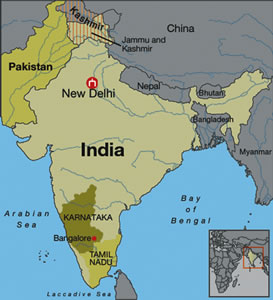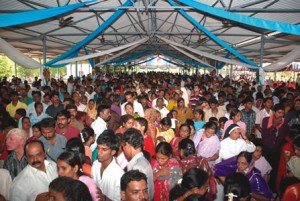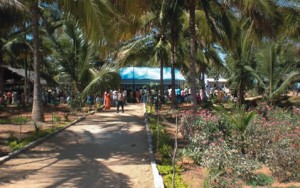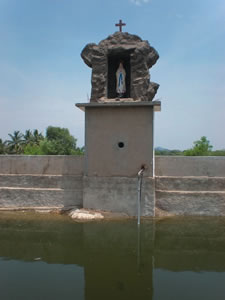Birth of a Pilgrimage – Miracle at Rayakottai
When Fr Joy bought a farm ten years ago in the little village of Nagamangalam, nothing let him forsee the amazing events which account for the fame of the place today. Thousands of pilgrims are flocking each week to take away water seen as miraculous.
One day in 2002, when I was still in charge of Rayakottai parish, where I had been since 1995, I was visited by Fr Joy, a Benedictine priest from Kerala. He told me he had bought a farm at Nagamangalam, 12 km north-west of Rayakottai, and therefore in the territory of this parish.
Fr Joy had been told that there was a church and a priest living at Rayakottai: hence his courtesy visit. At that time he was in charge of a small house of formation at Bangalore, for young candidates for monastic life. For some months he had been looking for a fairly secluded place in the country, to set up a farm there and, eventually, a monastery.
Up till then, the Benedictines had no presence in the diocese of Dharmapuri. In principle, any congregation or religious order must obtain the permission of the local bishop before opening a house in the diocese. Quite simply Fr Joy had not had the time to take this step, because the offer of sale for the farm had been made to him. This property had pleased him straightaway, and its owner was anxious for the sale to be made as soon as possible because he was waiting for the money so he could go and settle overseas. As well, several other buyers were interested. He had just had the time to ask permission from the Father Abbot of the abbey of Villambrosa, and the farm , about 9 hectares in size, was bought. Canonically, he knew he was at fault with the Bishop of the diocese of Dharmapuri; and that, among others, was the reason he had come to see me.
So we then met the Bishop, to whom I introduced Fr Joy as my new neighbour, making the point that the coming of a contemplative order into the diocese would be a great blessing for it. The bishop accepted the ‘fait accompli’ with joy and satisfaction. The only thing asked of Fr Joy was that he get from his superiors a formal request, which the bishop, with the consent of his council, would willingly approve.
THE FARM PROJECT: WORK AND PRAYER
Within a few months Fr Joy transformed that farm, which had been a bit neglected, into a model one. He had help from two or three families who had come from Kerala. That made communication easier for him, because at the beginning he knew nothing or almost nothing of the Tamil language in use throughout the state of Tamil Nadu. He found an abundant source of workers, both men and women, in two neighbouring hamlets, to work on the farm. Two large open wells, equipped with powerful electric pumps, existed already, and provided enough water to cultivate sugar-cane there, as well as tomatoes, aubergines and other vegetables. The cane was sold to the sugar refinery at Palacode, 40 km away, The vegetables, the tomatoes in particular, were taken to the market at Rayakottai, quite near the Catholic church.
During the first two years Fr Joy remained in charge of the house of formation at Bangalore. He had to go there fairly often because he had other responsibilities there. Nevertheless he came back as often as possible to his farm, which he really loved. On a regular basis he brought young candidates for the monastic life to it, in order to introduce them to farm work, this being an integral part of their formation.
Fr Joy already saw in this place a very interesting future for the monastic and contemplative life of this Benedictine foundation in India. He had done and was doing everything for that purpose with energy and discernment. As they became available, he acquired more neighbouring pieces of land, bringing the total area of the farm to 12 hectares. Meanwhile Father had obtained from his superiors a full-time appointment in charge of this farm which was taking up more and more of his time. He keenly sought the advice of farming experts to improve the productivity of the land. He planted more trees: coconuts, mangoes, over and above those existing already. Because Fr Joy was my neighbour, I often visited him, and it was a perfect delight, on each occasion, to be involved in an inspection of new acquisitions and achievements: the work which he loved, this adventure which he was impassioned about, really made him bloom. Sometimes he asked my advice on this or that project. And so it was that one day he told me he wanted to build a little chapel which would be dedicated to Our Lady of Lourdes. It was agreed that this chapel would be built facing the road, linked on two sides to the surrounding wall: this was to allow all those passing by to see the statue of the Virgin, and eventually to pray there. Even if, as far as we knew, there was not a single Christian family within 10 km radius. The population is overwhelmingly Hindu, with a small proportion of Moslems.
THE WATER
Everything seemed to be going very well for Fr Joy. But in 2007 an incident, seemingly insignificant at first, came and upset all the future plans for this Benedictine foundation coming into being. Five years had passed since Father had arrived in the area, One day he came and saw me at Rayakottai: “I want you to come to the farm,” he said to me, “I want your opinion about something going on. I don’t know how to understand it, and I admit I find it a bit frightening.” Joy led me towards the middle of the farm, and showed me a little hole in the ground about 30 centimetres deep: it was full of water, which was quite astonishingly clear. “So what ‘s concerning you about this little pond of water?” I said to him. He explained to me that a few days earlier, one of his workers was digging little holes in the ground to plant banana or coconut palms, when suddenly water filled the hole in question. The worker, who was astonished, but otherwise did not react,left that hole flooded with water, and went and dug a bit further along. The next day, when he went past, he found that the hole was full of water that had become crystal-clear and inviting to drink. The worker casually pointed it out to Father. He too was really astonished, partly by the clarity of the water, and especially by the fact that water could be found only a few centimetres below the surface.
The whole farm is in a valley running north – south, and is bounded at the bottom by a stream which has water in it only when it rains. Father had recently had a deep well dug beside this stream, thinking that there would be much more chance of finding water there than on the slope higher up . Not finding any, he had abandoned the project. Hence his great perplexity: how had he been unable to find water at several hundreds of metres depth, and by chance come across a spring two hundred metres higher, on the slope? But another event came and livened things up.
A CURE
Father had a tractor for the farm. From time to time he called on a mechanic to service it. The mechanic, who is a Hindu, was attracted by the wonderfully clear water, drank some and found it very good. Some days later he came back to see Father and told him something that worried him. “Father,” he said, “for a few years I have been a diabetic. I take medication and follow a strict diet. After my last visit here I had my usual check-up, and the doctor was surprised to see that my blood-sugar level had become normal. He told me to stop taking the medication and to come back in a week. I did that, and the blood- sugar level was still quite normal. The doctor could not understand it, and neither could I. But I had not told him about drinking that water, for fear of being ridiculed. In fact, Father, as soon as I had drunk that water, I remember having experienced an indefinable feeling in my body, without thinking too much about it before. But since my blood-sugar level became normal, I have thought about it a lot; I have come to get some of that water.”
Quite puzzled, Father also didn’t know what to make of this revelation. Convinced, miracle or not, that it was this water that had cured his diabetes, the mechanic shared his experience with other people and especially with diabetics. By word of mouth the news spread like wildfire. The number of people coming to get the water kept on growing. Which began to worry Fr Joy. That is why he had come to see me to tell me of his dilemma in face of these “happenings”. Meanwhile, other testimonies were given. Notably, a Moslem from the nearby village of Nagamangalam suffering from liver cancer and who had been sent home from the hospital because his case had been judged hopeless, came and drank some of the water and, as he had seen others do, he took away a full can of it. Every day he drank some of the water and, certainly, he felt better and better. The doctors at the hospital from which he had been discharged having examined him, found no more trace of cancer. Our worthy man spread the good news among his relatives. The Moslems hastened to the spring in greater and greater numbers.
Father was in more and more difficulty. We reflected on the situation together. This place had been bought, developed, and managed in the context of monastic life. As well, it is not part of the vocation of Benedictine monks to promote a pilgrimage centre. It was no longer possible to be involved with the farm, because Father’s days were more and more taken up with people coming to visit. As well, Father’s superiors, having been made aware of these developments, were strongly opposed to them, and were putting pressure on Father to forbid, once and for all, any people from entering the farm. His Benedictine confreres who came to see the situation for themselves, were not in favour of it either. The Bishop of the diocese, aware of what was going on, had told me: “It’s no doubt a passing infatuation: it will be enough to not encourage visits, and it will gradually come to an end.” “Bishop”, I said to him, “your analysis of the facts is perhaps worthwhile. But I notice one thing: usually priests and missionaries have to make an effort to go to people and get them to share the goal of our ministry. In the present case people of every religion are hurrying to draw and drink water in which they find curative power. There are many testimonies. Here is a very rare pastoral opportunity: why not take advantage of the situation to give to those coming something extra: offer them the word of God and, for the Christians, the sacraments of the Church?” Father Joy was convinced of that, although his interior struggle remained intense. He decided, in spite of inward and outward hesitation, to follow the direction of the events and began to put in place arrangements for welcoming visitors and their comfort.
RECEPTION OF THE PILGRIMS
The daily Eucharist began modestly in a makeshift shelter. At the site of the hole filled with water a little well, one metre wide and three deep, was dug. As well as hurrying there in great numbers, especially on Saturdays and Sundays, the people threw coins, medallions and other unusual things into it. The well was covered with a sheet of glass, and at that place the water was pumped into a raised reservoir. In the course of weeks and months, arrangements for pilgrim care increased in number and variety. Many people came without planning for food. A little canteen was provided for them. In less than two years the countryside of this rural and so peaceful locality was changed and had definitely taken on the appearance of a pilgrimage site. At weekends the crowd, numbering several thousand people soon began to gather in the mornings. Fr Joy, never taking notice of his efforts and his time, was constantly at the oven or the mill. His detractors and people with bitter minds didn’t let up in their criticisms, and their sometimes harsh attacks. Nothing seemed to be able to stop the people coming.
Five years have gone by since the beginnings of what has become, it must be said, a pilgrimage dedicated to Our Lady of Lourdes. Today a large esplanade has been built: a roof made of metal girders covered with fibrocement slabs, supported by pillars, leaving the sides open, can shelter 3000 to 4000 people. There the liturgies take place in which people of every belief take part. In the course of the years Fr Joy has been able to surround himself, effectively, with an important team of lay volunteers and religious women from neighbouring convents. He has made progress in learning Tamil, but for the convenience of the pilgrims, on Saturdays and Sundays, he invites Tamil priests who willingly come to help him. At each weekend liturgy it is common to meet there priests who have come from nearby dioceses, often accompanying groups of people. Many people come and testify in public about exceptional favours they have received. History gives plenty of evidence that these sorts of events usually attract opposition. Perhaps it is
necessary so that the truth speaks for itself. Fr Joy has been recalled to the mother–abbey of Villambrosa in Italy. Certainly with a heavy heart, he has obeyed. One of his Benedictine confreres replaced him three months ago. Although somewhat reluctant. It seems that he has got involved, in spite of himself, by the team of volunteers and the incessant flow of the pilgrims, many of whom are strongly attached to this place of spiritual renewal. Certainly the future will tell us more about the destiny of this place which seems marked out by a special favour.
From ‘Missions Etrangeres de Paris’, Feb 2013
Translated by Fr Brian Quin, s.m.



 Entries(RSS)
Entries(RSS)